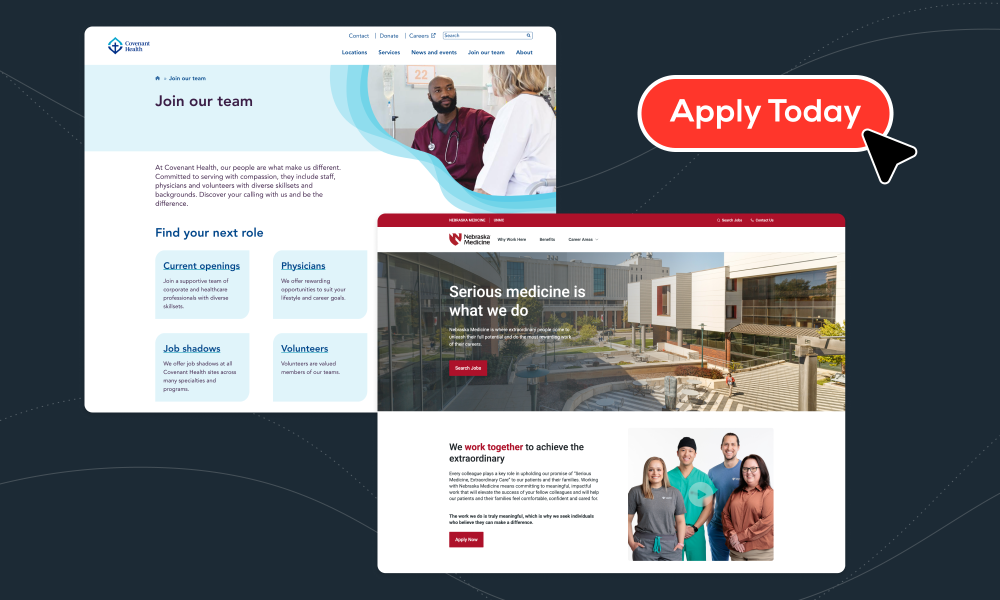How Hospital Marketing and HR Teams Are Rethinking the Career Page
How Nebraska Medicine and Covenant Health built better hiring experiences

Healthcare’s greatest growth challenge today isn’t patient demand — it’s staffing.
Across hospitals and health systems, empty positions don’t just slow operations; they limit care. And that’s put recruitment squarely on the radar of marketing leaders.
Where hospital marketing teams once handled recruitment as a series of one-off requests (job fair banners, social posts, or job board ads), they’re now stepping into a more strategic role. The career section of the website has evolved from a backend HR tool into one of the most critical assets for attracting and converting talent.
In this article, you’ll see how Nebraska Medicine and Covenant Health made that shift. Both organizations moved from supporting HR to truly partnering with them to redesign digital hiring experiences around what candidates actually want: clarity, relevance, and fewer barriers.
If you lead marketing at a healthcare organization, these lessons offer a practical playbook for turning your career page into a growth engine.
What It Looks Like When HR and Marketing Build Together
Covenant Health: Building a Hub Around Real Candidate Needs
At Covenant Health, the effort to redesign the career section wasn’t about a visual refresh; it started with a workforce challenge. HR needed help recruiting for staff roles, as well as for physicians, students, and volunteers across a wide geographic footprint.
Damian Finlay, who leads web and digital communications, worked alongside HR to evolve the website from a single job-listing redirect into a more complete “Join Our Team” hub.
What changed:
- Added audience-specific content for students, physicians, and volunteers
- Introduced profiles of rural communities to help candidates considering relocation
- Consolidated scattered information into a single, easy-to-navigate destination
- Balanced messaging and structure to reflect HR’s workforce strategy
Despite limitations with their Oracle recruiting platform, the collaboration helped shift the experience upstream to where first impressions are made.
“It wasn’t just about better UX. It was about helping people imagine a future with us.”
- Damian Finlay, Manager, Web and Digital Communications, Covenant Health
Nebraska Medicine: Planning Recruitment Like a Campaign
At Nebraska Medicine, the marketing team works with HR not just to respond to requests, but to plan the year together. This includes coordinating campaign timelines around seasonal hiring patterns, like the May influx of new nursing grads.
Their career section evolved to reflect this shared planning mindset. No longer a static job board, it’s now a flexible tool that supports targeted outreach and priority roles.
What changed:
- Introduced short forms for priority jobs to bypass HR platform friction
- Produced videos and staff testimonials with input from talent acquisition, to ensure they spoke to real candidate concerns
- Built content around questions HR knew candidates were asking
- Treated the site like an ongoing campaign instead of a one-time build
“They know the audience. We know the medium. So we figured out what matters most to candidates, and we built from there.”
- Frank Lococo, VP of Marketing and Communications, Nebraska Medicine
What These Two Teams Got Right
While the paths were different, both organizations landed on a similar playbook that any healthcare marketing team can learn from:
- HR and marketing collaborated from the start, not just at handoff. Planning and prioritization happened jointly.
- The career section became a tool for outcomes, not just information.
- They focused on practical, high-impact changes. Neither team needed a massive platform rebuild. Small, smart decisions moved the needle.

What Makes a Marketing and HR Collaboration Successful
Behind both of these examples is a simple shift: marketing stopped treating HR as just another internal client. They started treating recruitment as a shared strategic priority.
That shift didn’t require massive reorgs or full-site redesigns. It happened because of a few practical, repeatable habits:
1. Shared Planning, Not Just Shared Deadlines
The most effective collaborations didn’t begin with “Can you build this page?” They started with joint planning cycles: mapping key dates, role priorities, and campaign needs across both teams.
At Nebraska Medicine, that meant knowing in January that recruiting season for nurses would peak in May. Marketing could plan ahead for video production, short-form workflows, and campaign messaging without sacrificing bandwidth elsewhere.
“Planning together doesn’t just reduce scramble, it unlocks better work.”
- Frank Lococo, VP of Marketing and Communications, Nebraska Medicine
2. Clear roles, shared purpose
These teams didn’t blur roles; they respected them.
- HR brought audience knowledge: what candidates ask, what roles matter, what recruiters need.
- Marketing brought storytelling and UX: how to make information persuasive, navigable, and credible.
That division of strength helped keep the scope focused. It also made it easier to push back or reprioritize when needed because the “why” was shared.
3. A Candidate-First Mindset
Every decision focused on making it easier for job-seekers to see themselves in the role.
That meant:
- Speaking directly to job-seekers’ questions
- Using real voices and visuals from current staff
- Reducing friction in the application process
- Creating useful hubs, not just listings
A better career section doesn’t come from guessing. It comes from listening, simplifying, and building what candidates actually need.
Challenges That Remain on the Roadmap
While both teams have made real progress in elevating the career section as a strategic asset, they’re also clear-eyed about what still needs work.
1. Smoother Connections to the ATS (Applicant Tracking System)
One of the biggest shared challenges is the disconnect between the career section and the applicant tracking system. Candidates are often taken from a modern, branded web experience into a more transactional, less intuitive third-party interface.
Both teams are exploring ways to minimize that disruption:
- At Nebraska Medicine, they’ve introduced short-form interest submissions for priority roles like nursing, creating a softer entry point into the hiring process.
- At Covenant Health, the team is looking at how to better align the candidate experience across platforms, while acknowledging current system constraints.
“Our long-term goal is to bring more of that experience into our own ecosystem. It’s not just about branding, it’s about clarity and flow.”
- Damian Finlay, Manager, Web and Digital Communications, Covenant Health
Neither team sees this as a technical limitation they simply have to accept. It’s an area they’re actively working on through roadmap planning, data integration efforts, and conversations with HR, IT, and platform vendors.
2. Better Analytics Across the Candidate Journey
With most tracking tools cut off once users enter the ATS, it’s difficult to get a full picture of what’s working. This has real implications. Not just for campaign attribution, but for understanding drop-offs and optimizing conversion paths.
Here’s how the teams are addressing it:
- Campaign traffic is routed through the website first, so top-of-funnel engagement is trackable
- Outbound clicks to the ATS are monitored, creating at least partial insight into handoff behavior
- Future plans include exploring middleware options or deeper integrations to restore end-to-end tracking
3. Continuous Improvement Is the Model
Neither team views the career section as a static product. Instead, it’s something they’re actively iterating based on new insights, hiring patterns, and audience feedback.
Current areas of focus include:
- Conducting UX evaluations to better understand drop-off points
- Running focus groups with recent hires to validate assumptions
- Continuing to refine messaging and structure based on real recruiter and candidate input
What’s most notable here isn’t just the specific tactics, it’s the mindset: ongoing refinement, not launch-and-forget.
Collaboration with HR doesn’t require a reorg or a blank check
If you’re leading marketing at a hospital or health system, your website’s career section may be one of your most under-leveraged tools. It’s become a critical channel for reaching, converting, and supporting the people who make care possible.
What Frank Lococo and Damien Finlay show us is that effective collaboration with HR is mutually beneficial. It requires intention, planning, and a willingness to shape digital tools around real user needs.
There’s still plenty to solve but the most important shift is already underway. When marketing brings strategic thinking to the candidate journey, the impact is felt across the organization… And by the people deciding where to build their careers.
PS: You can find out more about how Symetris helped Covenant Health by checking out our linked case study.
